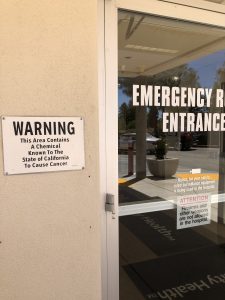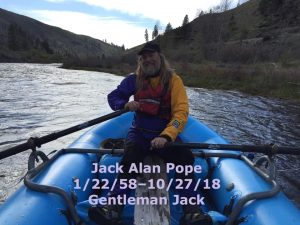In the two and half years my husband Jack fought his cancers, we worked with over ten different doctors. Our journey began at the local hospital, circled to Stanford and up to UC Med in Sacramento, and then took an unlikely turn to Eureka, California. We spent many hours in consultation, Jack more hours than I can count in treatment. The doctors were usually sub-par but occasionally stellar. The doc who helped us the most is the only one we never met in person: Michael Fratkin, M.D.
I have a two-pronged relationship with our insurance company, calling it alternatively Blue Shield and Blue Dagger. My complaints are common; the company routinely denies scans until the doctor requests them three times. That’s why we made the news last winter when Jack was rescued by a snowmobile and rushed to UC Med for brain surgery. Had the scans been approved when first requested, we would have had plenty of time to get him treatment. But that’s another story. By far the best thing Blue Shield did for us was to connect us to Dr. Fratkin and his new company, Resolution Care.
Blue Shield routinely hooked us up with one of their RNs by phone after each hospitalization. So when we returned from a humiliating two-day observation stint at UC Med, Laura the RN called. She was a very good listener, and I still love her to this day. “I think I have something that will help,” she offered, “and it’s totally covered.” Those were words I didn’t hear often, and I perked up, pushing the five-digit total of medical debt out of my mind for a moment.
As she explained, Resolution Care administers palliative care with telemedicine. We’d meet via Zoom with Dr. Fratkin each week, and I would be in frequent contact with his nurse Kathy via Zoom, phone, or email. Beyond palliative care, Resolution Care coordinates care for complex cases such as Jack’s. It also takes over the meds, which is huge.
So Jack and I squished together on the couch to both fit into the screen of my iPad. We met a kind man who looked a little like a younger version of Jack. He looked at us deeply, thoughtfully. He listened. We felt immediately that he cared for both of us.
He is one of two doctors we saw who thought to ask how I was. It felt good to be part of his equation. Neither of us was doing well since my husband’s multiple brain melanomas had been misdiagnosed by UC Med as “just sciatica and only one herniated disc.” We learned later that one tumor was causing the sciatica-like pain. The confusion caused by brain swelling they dismissed as opiate-related. Dr. Fratkin adjusted Jack’s meds and watched closely for a few weeks. Home Health came and monitored. Then, one morning in September, things took a significant turn.
Liz, the wonderful Home Health nurse, could not get a stable blood pressure. Other symptoms pointed to a UTI. Given our rural locale and Jack’s very weak state, she recommended I call 911 and go to the local ER.
Once there, I immediately emailed Kathy to get Dr. Fratkin in the loop. The ER doc, who I’ll call Dr. Silver, ordered blood and urine tests and a cat scan of Jack’s back, all of which were normal. They declined to order a cat scan of his brain because he’d had a clear MRI in June. Jack looked to me like someone who needed to be in the hospital, but he met none of the criteria. Dr. Silver looked at me sternly. “He’s on a lot of narcotics, you should think about that.” I told him about our new doctor, the doctor we had only met through Zoom. He became suspicious and skeptical and said he’d never heard of such a thing and that he was shocked insurance would approve it. I emailed a report of his comments to Kathy. “That’s disappointing,” she replied. “And Dr. Fratkin is calling him right now.” I felt myself smile.
Dr. Silver returned moments later and for the first time took a chair. “I just got off the phone with Michael Fratkin, and it’s unbelievable, but I know him. We were in med school together. He’s an amazing doctor, a pioneer. You are in good hands with him.”
Then he repeated that Jack didn’t meet terms of admission and that I should seriously consider how many narcotics he was on. An orderly helped me somehow get Jack in my car, and somehow I got him safely out and back to our couch that had become like a permanent home to him.
Dr. Fratkin checked in the next day, and the day after, as symptoms worsened. He called and asked to speak to me privately. “Do you think he’s dying, Carolyn?”
“It seems like it,” I said. But they keep telling us it’s not cancer.”
“Do you have any steroids left over from the spring?”
I went and looked. I had 12 one-milligram tablets. Jack had taken steroids while he recovered from the surgery that had removed the orange-size melanoma from his frontal lobe last March.
“Give him six, and I’ll call you in thirty minutes. If his brain cancer’s back, the steroids will tell us.”
I knew just what he meant. I settled Jack on the couch and grabbed a quick shower. When I came out, he was sitting up as if he were well. He had dressed in his town clothes–t-shirt, Levi’s, and white Nikes–and sat with one ankle crossed over his other thigh like he used to, with the elevated foot tapping the air a little as he thought.
“I feel a lot better!” he said. I stuffed the well of tears down my throat into my gut. No time for that now.
Dr. Fratkin called back. “Oh no,” he said. Understandably, I was reluctant to go back to the ER and the stern Dr. Silver. But Dr. Fratkin had already come up with a plan. He phoned the ER and got the admitting doctor to agree to admit Jack and order a cat scan of his brain. Jack hopped into the car like old times. His sciatica had magically disappeared. I kept the tears in my gut and focused on the road.
Within a couple hours, we had a terminal diagnosis.
Since the same ER had rejected us two days before, I wasn’t about to take their word for it. Dr. Fratkin appeared on my phone via FaceTime. He appeared on the phones of the ER doctors as well, baffling them with the professional use of such technology. He asked to talk to Jack, who by that point was psychotic. “I promise you won’t die here, Jack,” he said. “I will get you home.” My jaw dropped. Dr. Fratkin asked again to speak with me privately, so I took him out in the hall.
“You have every right to transport,” he said, “but it will be hard on both of you.” He offered to call Dr. Fragosa, the radiation oncologist at UC Med who’d treated Jack last spring. He called me back a few moments later. He and Fragosa had studied the cat scan report together, and Dr. Fragosa confirmed the diagnosis. We were saved a grueling 12-hour stint in the ER at UC Med—not to mention the four hour round trip commute.
A few days later we were home on Hospice. Jack was enjoying some relatively pain-free, lucid days after the meds were dialed in. Dr. Fratkin called. “It’s a beautiful day,” I said, looking through the screen door out at the sunny morning. “I’m looking at the dogs and the morning glories.”
“Would you send me photos?” he asked. “I want to see that.”
I did, and he sent me some photos too. Six weeks later, I sent him one more.
Friends have started a GoFundMe to help CC with Jack’s medical bills. Please share widely and contribute if you can.





I’m so sorry, Carolyn. I had no idea you were going through this. My son’s father died from brain cancer at 47. Sounds like you and Jack went through hell with the medical system. Much love to you.
Thank you so much, Peggy. I miss you and love you. Maybe I can come visit soon.
That would be wonderful. Please come soon. Love and light,p
Brilliant essay Carolyn. You really capture of the nightmarish quality of health care in this country today, as well as the dedication and love and commitment that you and Jack had for each other, and that you found in some others as well, like this Dr. Fratkin. May he continue his work for a long time, and may you continue your healing. You’re a badass woman to have survived all this with your grace intact. I love you so much honey.
Thank you for being there every step of the way, Sweetheart. I love you so much too!
Thank you for sharing your agonizing ordeal and brave struggles, Carolyn. You write about it so poignantly, I’m so sorry to read about your devastating loss. You and your husband obviously shared tremendous strength as well as love, and I hope this will sustain you going forward. We all process grief differently, I hope you can take comfort and support in the love of your family and friends (including those of us “out here” in internet-land).
Thank you so much, Irene. I am surrounded by friends, family, and students who are so thoughtful and supportive. And I have the doggies. I hope you are well and happy.
Carolyn, sharing this story, especially as well as you tell it, is such an amazing gift, to anyone going through similar circumstance, to any one who needs to understand what love, commitment, and perseverance is all about. My deepest condolences on your loss. Sending much love to you.
Thank you Maggie, for such kind words. Love to you, Luke, and the boys.
Carolyn, Thank-you! I am glad I read this just now. Lunch today was so nice and now I understand your journey with Jack a bit more. This adds one more layer to this bitttersweet time! Love you! You are so strong! XO
Thank you, dear Kellye, for your love and support. There is nothing quite so therapeutic as laughing and crying at the same time. Thank you for helping me coin the “Yay Jack!” phrase. He lived life on his own terms, loved deeply, and like you, me, and Paul, was lucky enough to find the love of his life while on the planet. The next time I look over the land when the light is right or I find one of his favorite things, I’ll say, “Yay Jack!”